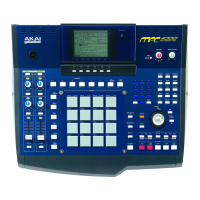Chapter 3—Creating and editing a sequence
18
Preparations for creating a sequence
Before you can record MIDI events in a track, you must specify certain parameters such as the number of
measures, the time signature, and the tempo.
1. Press the [MAIN] key.
The main page will appear. Most of the steps involved in creating a sequence are performed in this page. Set
the parameters of the sequence in the sequence block described below.
A Position bar: This shows the current position within the sequence. The full length of the bar graph cor-
responds to the length of that sequence.
B Now field: This shows the current position within the sequence in measures/beats/ticks.
C Time field: This shows the current position within the sequence in hours/minutes/seconds/frames.
D TC field: Here you can specify the note value that will be the minimum unit for timing correction (quan-
tization).
E Swing field: In this field you can specify the amount of “swing” by which the backbeats will be moved
forward or backward. This will be displayed if you have selected 1/8, 1/16, 1/32, or 1/64 in the TC field.
F Metronome field: Here you can switch the metronome on/off.
G Seq field: Here you can select the sequence that you want to record or edit. The field will show the name
of the currently selected sequence.
H Tempo field: Here you can set the tempo of the sequence.
I Loop field: Here you can switch loop playback on/off for the sequence. The field immediately below
the Loop field lets you change the loop region. The loop region is shown as in the position bar.
J Bars field: This opens the Change Bars popup window which lets you specify the number of measures
in the sequence.
K Time signature field: This opens the Change Time Signature popup window which lets you specify the
time signature of the sequence.
L A.Punch field: Here you can switch the auto punch-in/out function on/off.
M Sync field: Here you can switch synchronization with external devices on/off.
N Sequence trans. field: This lets you transpose an entire INST type track in a range of –12–+12 semi-
tones.
2. Move the cursor to the Seq field, and turn the [JOG] dial to select an empty sequence.
When an empty sequence is selected, the Seq field will indicate “x- (Unused)” (x will be a sequence number
in the range of 1–128). An empty sequence will have default settings of time signature = 4/4, measures = 2,
and tempo = 120.
3. Move the cursor to the Bars field, and turn the [JOG] dial.
Hint: When you turn on the power, all sequences will be empty.
When you record MIDI events into a sequence, a sequence name of “Sequence_xxx” (where xxx is a sequence
number in the range of 1–128) will be assigned automatically.
If the cursor is in the Seq field, you can press the [WINDOW] key to access the Sequence popup window in which
you can change the sequence name or edit the entire sequence (
→
p.36).
1
45 6
7
2
8
9J
K
L
M
N
3

